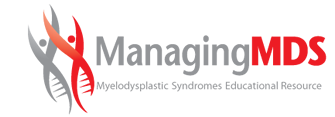Updates in MDS: A Special Edition on Higher-risk Disease
 |
Mikkael A. Sekeres, MD, MS
Professor of Medicine Chief of the Division of Hematology Sylvester Comprehensive Cancer Center University of Miami Miller School of Medicine Miami, Florida |
|
How is high-risk MDS defined and distinguished from low-risk MDS?
Although it can be somewhat difficult to distinguish different risk types of myelodysplastic syndromes (MDS), it is critical to do so, not only for providing information to a patient about his or her prognosis, but also for determining therapeutic options, because goals of therapy are different for lower- versus higher-risk MDS.
MDS risk is most commonly defined using the International Prognostic Scoring System in its original or its revised version. This tool uses basic clinical characteristics to distinguish lower-risk MDS from higher-risk MDS. For example, a patient with a very high blast percentage, multiple cytopenias, and poor-risk genetics is considered to be a higher-risk patient. On the other hand, patients with low blast percentages, isolated, mild anemia and good karyotype – perhaps a deletion 5q abnormality – would be considered to have lower-risk disease with low likelihood of acute myeloid leukemia (AML) evolution. One thing that has changed over the past decade is the incorporation of molecular mutations into risk assessment. Now, it is more likely that a patient who has a TP53 abnormality, ASXL1 mutation, or RAS mutations will fall into the higher-risk category, whereas patients who have an isolated SF3B1 mutation may actually have lower-risk MDS.
How do treatment goals differ between lower- and higher-risk MDS?
When you have a patient who has higher-risk MDS who is at risk of evolving to AML, your goals for that person are to try to prevent that evolution to acute leukemia, and initiate therapy that’s going to prolong that person's overall survival. For a person with lower-risk MDS, treatment should center on the patient’s individual goals. For a person with lower-risk MDS, perhaps with mild anemia, we do not typically start therapy unless we absolutely have to. In these cases, we would wait until the patients starts requiring transfusions or his or her quality of life begins to suffer greatly from the side effects of the MDS.
What is the current treatment landscape for MDS?
For higher-risk MDS, there are fewer treatment options compared with lower-risk MDS. These patients often have multiple cytopenias and high blast percentages, and there is strong evidence supporting our treating these patients with one of the hypomethylating agents, either azacitidine or decitabine. Azacitidine is the only drug that has been shown prospectively in a randomized trial in higher-risk MDS patients to prolong overall survival, with an approximate doubling of survival at two years versus conventional care regimens.1 In these patients, we might also initiate a conversation about bone marrow transplantation (BMT). BMT is the only cure for MDS. There have been two decision analyses2,3 demonstrating a potential survival advantage in initiating BMT upfront for a patient with higher-risk MDS, but that survival advantage does not occur in patients with lower-risk MDS.
What are the most exciting new advances in the treatment and management of patients with high-risk MDS?
In higher-risk MDS, these patients tend to have more genetic abnormalities. Some of these molecular abnormalities could now potentially be targeted with new drugs. For example, there are two drugs that have been approved by the FDA for the treatment of AML that has either an IDH1 or an IDH2 mutation. A subset of patients enrolled on those pivotal trials that led to that approval actually had higher-risk MDS. It turns out they responded about as well as patients who had AML.
There is a new drug that has been developed for use in combination with azacitidine. The new drug – APR-246 – targets TP53 abnormalities and restores TP53 function. Phase 2 trial results of this agent look very promising, with a high response rate, and an interim analysis of phase 3 results4 demonstrated improved complete remission rates, although we have yet to see an improvement in overall survival for patients who received the combination of azacitidine and APR-246 versus azacitidine alone.
Other combinations that have been explored include a North American Intergroup trial which randomized higher-risk MDS patients to receive azacitidine monotherapy, azacitidine combined with lenalidomide, or azacitidine combined with the histone deacetylase inhibitor vorinostat.5 Although the study found no significant differences in overall response rates between the groups, it revealed a surprisingly high percentage of patients whose doctors lowered their doses of one or both of the combination drugs or stopped them prematurely due to concern over side effects. If these patients had stayed on the drugs long enough, we actually may have seen the improvement in response rates and maybe even the improvement in survival that we were hoping for.
That taught us in designing a randomized trial of azacitidine and the NEDD8 inhibitor pevonedistat versus azacitidine alone6 to have very strict language about not lowering doses and not discontinuing therapy prematurely. My colleagues and I recently presented data on this phase 2 study,7 which involved hypomethylating agent-naïve patients with high-risk MDS, high-risk chronic myelomonocytic leukemia (CMML), or oligoblastic acute myelogenous leukemia (AML). The data were in favor of the combination of pevonedistat plus azacitidine, with improved event-free survival and overall survival. Among those with high-risk MDS, the overall response rate was around 80% and the complete remission rate was around 50%. This combination also extended transmission independency and delayed transformation to AML.
Interestingly, the adverse events profile appeared to be similar in patients who received the combination of azacitidine and pevonedistat versus azacitidine alone, which may reflect protocol compliance and longer duration of combination therapy. It is important to note that pevonedistat does not appear to add significant myelosuppression or other toxicities to azacitidine therapy. The toxicity profile of this combination is actually quite acceptable. And although we still need to learn more in terms of mutational profiles that respond to this doublet, the bottom line is that we saw responses in different mutational groups, including P53-mutated patients, so that is very exciting. We are all eager for results from a larger study of this combination that should be released later this year.
How might these advances be applied to the treatment of high-risk MDS?
There are currently several ongoing advanced-phase trials for which results will be released this coming year, including a follow-up study of azacitidine and pevonedistat. What we're hoping is that that this combination will actually be found to benefit patients more than azacitidine monotherapy, and will lead to the very first approval of upfront combination therapy for patients with high-risk MDS. We are also waiting for further follow-up results for the combination of azacitidine and APR-246 to see whether there is some benefit for patients to get a TP53-targeting agent.
But what is available to doctors for use right now are drugs that target some of these molecular abnormalities. For example, if first-line therapy for patients with higher-risk MDS involves azacitidine, eventually that drug will fail, and patients will relapse. If one of those patients has an IDH abnormality, then that patient can be treated with one of the IDH inhibitors that are now approved for AML. Alternately, if that patient has an FLT3 abnormality, there are a variety of FLT3 inhibitors that have been approved for AML that could serve as second-line therapy. The point is that we now have some potential treatment options after hypomethylating agents have failed patients.
What are the most pressing gaps in MDS treatment today?
One of the most obvious gaps is the need for better upfront therapy for higher-risk MDS. While the pivotal phase 3 trial of azacitidine monotherapy demonstrated a median survival advantage of 24 months,1 the results of this study have never been duplicated; subsequent studies have all shown median survivals around 19 or 20 months.
A second treatment gap is second-line therapy once patients have been exposed to hypomethylating agents. We just do not have great therapies to offer them at that point with the exception of those few patients who have a targetable mutation. For the remaining patients, we can offer either low- or higher-dose chemotherapy, but most will return to transfusions with the hope that they will live beyond just a few months.
What final comments do you have on emerging treatments for higher-risk MDS?
There are a tremendous number of drugs that are in development for patients with higher-risk MDS, many of which are intended to be given in combination with hypomethylating agents. These include not only pevonedistat and TP53-targeting drugs, but also a smoothened inhibitor, several checkpoint inhibitors, and monoclonal antibodies. Finally, there is the combination of azacitidine and venetoclax that has been approved for the treatment of older adults with AML, and might be useful in higher-risk MDS, although the optimal dose and schedule is still being determined. These are exciting advances in higher-risk MDS treatment that will hopefully usher in a new era of MDS care.
References:
- Fenaux P, Mufti GM, Hellstrom-Lindberg E, et al. Efficacy of azacitidine compared with that of conventional care regimens in the treatment of higher-risk myelodysplastic syndromes: a randomised, open-label, phase III study. Lancet Oncol. 2009;10(3):223-232.
- Koreth J, Pidala J, Perez WS, et al. Role of reduced-intensity conditioning allogeneic hematopoietic stem-cell transplantation in older patients with de novo myelodysplastic syndromes: an international collaborative decision analysis. J Clin Oncol. 2013;31(21):2262-2270.
- Cutler CS, Lee SL, Greenberg P, et al. A decision analysis of allogeneic bone marrow transplantation for the myelodysplastic syndromes: delayed transplantation for low-risk myelodysplasia is associated with improved outcome. Blood. 2004;104(2):579-585.
- Global Newswire. Aprea Therapeutics Announces Results of Primary Endpoint from Phase 3 Trial of Eprenetapopt in TP53 Mutant Myelodysplastic Syndromes (MDS). December 28, 2020. https://www.globenewswire.com/news-release/2020/12/28/2150874/0/en/Aprea-Therapeutics-Announces-Results-of-Primary-Endpoint-from-Phase-3-Trial-of-Eprenetapopt-in-TP53-Mutant-Myelodysplastic-Syndromes-MDS.html. Accessed April 7, 2021.
- Sekeres MA, Othus M, List AF, et al. Randomized Phase II Study of Azacitidine Alone or in Combination With Lenalidomide or With Vorinostat in Higher-Risk Myelodysplastic Syndromes and Chronic Myelomonocytic Leukemia: North American Intergroup Study SWOG S1117. J Clin Oncol. 2017;35(24):2745-2753.
- Sekeres MA, Watts J, Radinoff A, et al. Randomized phase 2 trial of pevonedistat plus azacitidine versus azacitidine for higher-risk MDS/CMML or low-blast AML. Leukemia. 2021 Jan 22 [Epub ahead of print].
- Sekeres MA, Watts JM, Radinoff A, et al. Efficacy and Safety of Pevonedistat Plus Azacitidine Vs Azacitidine Alone in Higher-Risk Myelodysplastic Syndromes (MDS) from Study P-2001 (NCT02610777). Abstract 653. Data presented at the 62nd American Society of Hematology (ASH) Annual Meeting and Exposition; December 5-8, 2020.
This activity is supported by an educational grant from Millennium Pharmaceuticals, Inc., a wholly owned subsidiary of Takeda Pharmaceutical Company Limited.
